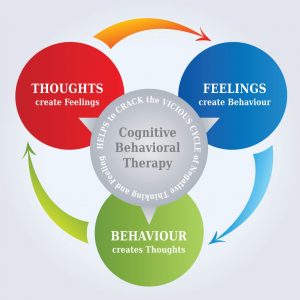Behavioral Techniques
 The idea being that if I can recognize times where an engaging and dysfunctional thinking and I can dispute these thoughts, I can replace them with more logical thoughts that will lead to more productive feelings and behaviors. Just as cognitive theory starts out as separate from behaviorism and from behavioral techniques, rational emotive behavioral therapy (RET) starts out without the B. It starts out as rational emotive therapy separate from behaviorism, and these behavioral techniques. And then, similar to Beck’s cognitive approach, behavioral techniques are integrated over time and the approach is renamed REBT, or rational emotive behavior therapy. One area where students tend to get confused is related to the differences between REBT (Ellis)and CBT (Beck)and that’s because there are many similarities between the approaches in terms of the way that they understand client concerns. Practitioners from both approaches would agree that one’s thinking influences one’s feelings and behaviors.
The idea being that if I can recognize times where an engaging and dysfunctional thinking and I can dispute these thoughts, I can replace them with more logical thoughts that will lead to more productive feelings and behaviors. Just as cognitive theory starts out as separate from behaviorism and from behavioral techniques, rational emotive behavioral therapy (RET) starts out without the B. It starts out as rational emotive therapy separate from behaviorism, and these behavioral techniques. And then, similar to Beck’s cognitive approach, behavioral techniques are integrated over time and the approach is renamed REBT, or rational emotive behavior therapy. One area where students tend to get confused is related to the differences between REBT (Ellis)and CBT (Beck)and that’s because there are many similarities between the approaches in terms of the way that they understand client concerns. Practitioners from both approaches would agree that one’s thinking influences one’s feelings and behaviors.
They would likely also agree that people have a choice over their actions or their behaviors, however, they would probably say that some decisions are made instantaneously and that the thought processes behind these decisions are a lot less conscious. So, when we’re talking about the ways of understanding the overarching differences are really found in the terminology. So, for example, Beck would refer to ‘cognitive distortions’, where Ellis is going to call this ‘stinking thinking’. Similarly, Ellis is going to talk about ‘irrational beliefs’ and Beck is going to call these ‘core schemas’ or ‘core beliefs’. But they’re talking about similar ideas and over time, Beck and Ellis both embrace behavioral techniques as a part of their approaches and integrate them in as part of their approach. So, as a result, they would both likely agree through practice, repetition, and reinforcement we can re-train the way that we think. And we can critically look at our thought patterns and the way that they lead us to feel and respond to different life circumstances.
The most striking differences between CBT and REBT are not in counselor ways of understanding, but are really related to counselor ways of being and their ways of intervening in the counseling relationship. So, an REBT counselor is going to tend to be more directive. They’re going to be a little more forceful in the way that they confront things. They definitely tend to use more humor and more self-disclosure, in a way, to sort of teach. They’re taking on kind of a role of teacher, and the counselor is definitely more active in terms of how they’re identifying irrational beliefs and disputing them.
When intervening with a client by behavioral techniques comparison, in CBT the counselor is still somewhat directive, however it’s a much more collaborative style, generally. And their way of intervening is going to be more consistent with Socratic questioning, which is going to put much more of an emphasis on the client discovering distorted thinking for themselves. Over the years, other flavors of cognitive behavioral approaches beyond Beck’s (cognitive) and Ellis’ (REBT) have been developed.
Some examples include: reality therapy, dialectical behavioral therapy, acceptance and commitment therapy, multimodal therapy, and mindfulness based approaches..

[pdf-embedder url=”https://simplehealthexercises.com/wp-content/uploads/2019/10/Limitless-Mind.pdf” title=”Limitless Mind”]





An outstanding share! I have just forwarded this onto a co-worker who was doing a little homework on this.